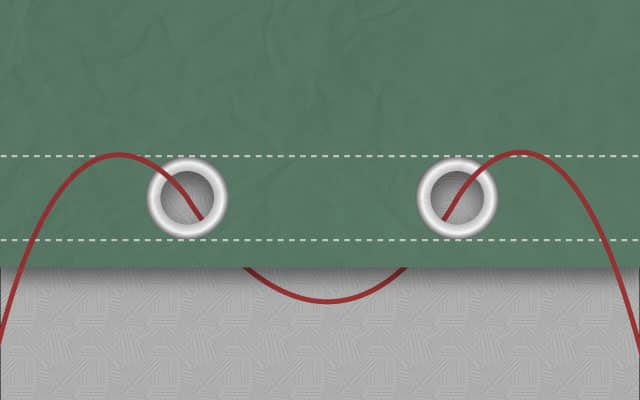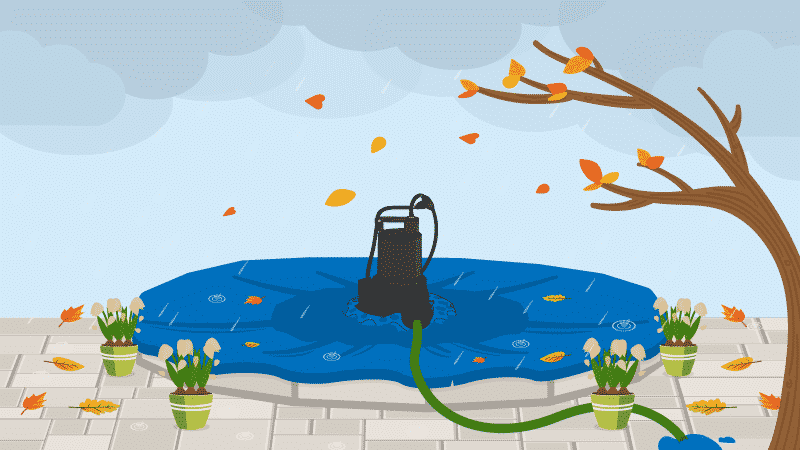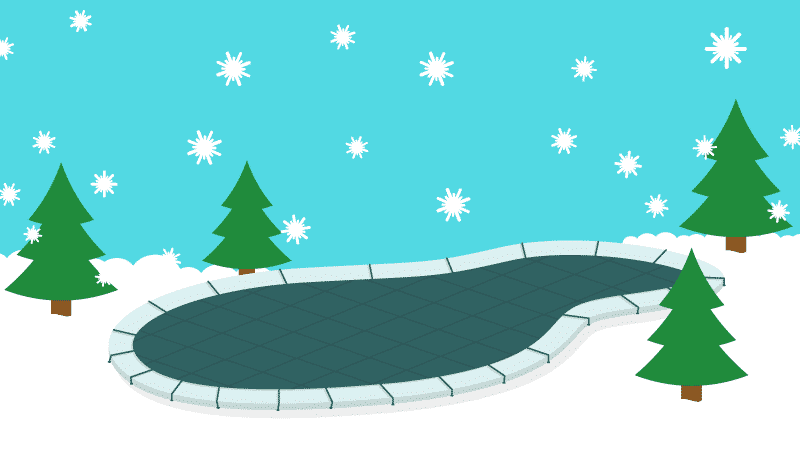How to Keep Your Pool Cover From Sagging
We share some no-nonsense DIY strategies to fix your sagging pool cover, keep it snug, and ensure it doesn’t get destroyed over the winter months. In this article, we’ll cover:
- How to quickly drain water off the cover.
- How to blow debris off the cover with ease.
- How to fix a sagging inground pool cover.
- How to fix a sagging above ground pool cover.
- How to protect your pool cover from future damage.
How to Quickly Drain Water Off Your Pool Cover
The fastest way is to use an electric pump. For an inground pool with a safety cover, you can use an automatic submersible pump (sump pump). Here’s our favorite inground winter cover pump. 👇
This powerful pump moves water quickly and can lift it very high. It has a special switch that drains water super low without letting it flow back. The quiet, waterproof design won't rust and keeps junk out while being easy to carry and store. Great for emptying pools, tubs, and fixing flooded areas.
- Connect your garden hose to the pump.
- Place your pump in an area where most of the water collects. This will probably be the center of the cover. And place your garden hose in a good drainage area.
- Plug in the pump and activate the switch to enable its automatic water detection function. The pump will start removing water, expelling it to a designated drainage area effectively.
An automatic cover pump is a significant time-saver, ensuring your pool cover remains clear of water even when unattended. However, these units aren’t cheap. For pool owners where the cost is prohibitive, a manual pump offers a budget-conscious solution.
If you have a tarp cover, you want to invest in a specialized pool cover pump. These lightweight pumps are designed for tarp pool covers. Here’s our favorite winter cover pump. 👇
This lightweight pool cover pump removes standing water from above ground pool covers. Includes a removable intake screen for easy cleaning and maintenance, 3/4-inch garden hose connection, and a 550-gallon per hour flow rate.
- Hook up your garden hose to the pump.
- Put the pump in a spot on your pool cover with the highest water accumulation.
- Lay out the discharge hose so it drains where you want it to.
- Plug in the pump to start draining water off the cover. There’s no on/off switch.
- Slide the pump around the cover to catch all the water hiding out there. Make sure not to let the pump run dry.
- Unplug the pump once your cover looks dry.
Finally, you could use a siphon. This is the cheapest option and works best if you have an above ground pool because of the gravity you need to keep the siphon flowing. You can use a short garden hose or PVC pipe and create the siphon yourself. But we recommend investing in a cheap pool cover siphon that lays in the middle of the cover.
This eco-friendly, energy-saving siphon pump offers a practical and cost-effective solution for removing water from pool covers. Its easy operation requires no electricity, simply activating with a squeeze to clear away water.
How to Get Debris and Leaves Off Your Pool Cover Without Ripping It
The best way is to use a leaf blower. This will only work if you already removed all the water from the cover and the debris is dry. My favorite leaf blower is the one below. 👇
This powerful and easy-to-use leaf blower will not only perform well on your lawn, but is great around your pool and hot tub.
If the cover is still wet, and the leaf blower option won’t work for you, you can use a soft broom or skimmer net. Be very careful, as even a soft broom can damage the cover. Also, make sure you don’t walk on the cover to perform this step.
If you want to keep leaves and debris off the top of the pool cover, you can invest in a leaf net. This net goes over your pool cover and collects the leaves. After a huge fall, you can simply remove the leaf cover, shake the leaves off, and replace the leaf net on top of the cover for when it happens again.
This leaf net pool cover is crafted from durable woven polyethylene in a black mesh fabric. It conveniently prevents debris and decaying leaves from creating a mess, featuring a 4-foot overlap to accommodate most pool copings.
How to Fix a Sagging Inground Pool Cover
There are two types of inground covers: pool safety covers and winter tarps. For safety covers, the best you can do is make sure there’s no water on the cover and that the straps are all tight.
For a tarp cover, you want to make sure you have enough filled water bags/tubes around the pool to keep the cover in place. If some of the water bags don’t have enough water, you need to fill them up.
The tarp should be resting on the pool surface. There’s no way to get your tarp cover as tight as an installed safety cover. So sagging might be because of the low water level in your pool. If you lose some water, put a hose under the cover to fill it back up and raise the cover.
If your cover still feels too saggy, you can add a pool air pillow under the cover. This will help spread out the debris and rain/snow water so it doesn’t all collect in the middle and drag down your cover.
NOTE: If your cover is too old, it might be time to invest in a new safety cover. We put together a list of the best winter pool covers here. It includes inground safety covers and tarp covers.
Stop wasting time and money with confusing water chemistry and maintenance. Our effortless system guarantees to keep your pool balanced, sanitized, and crystal clear all year. Works for all pools including saltwater.
How to Fix a Sagging Above Ground Pool Cover
You don’t want to buy a new cover every year. It’ll last longer if you take proper care of it.
1. Secure the Cover
If you’re buying an above ground winter pool cover for the first time, make sure you buy a good heavy-duty cover with grommets. These are holes around the edge of the cover with metal rings. If you just use a plastic tarp, it may not have grommets, and it’ll be more difficult to secure.
If you buy a winter cover designed for above ground swimming pools, it should come with a cable and a winch to ratchet down the cover. Wrap the winter cover under the rails and loop the cable through the grommets. Make sure it’s nice and tight when you ratchet it down.
Here is how you properly loop the cable through the grommets on an above ground winter pool cover.

2. Use Cover Clips
We recommend using these in addition to the cable-and-grommet cover. The clips are just an added level of security.
They’re simple devices that clip on the cover directly under the above ground pool rail. They’re inexpensive, so the more you use them, the better.
Highly recommended to secure your winter cover to your above ground pool in conjunction with a cable and winch system. Add 1-3 per railing section for the best security.
3. Add Water to the Cover
Even tied down, a cover is susceptible to the wind. One good gust under the cover can blow it off, and repeated gusts can tear it.
Adding just one to three inches of water on the cover top will help protect it from wind damage. Remember to keep an eye on the water level, though. If it rains and you get too much water on top, the cover may sink down into the pool water. Keep a pool cover pump handy to remove excess water.
The same goes for snow. If you allow too much to accumulate, the weight will push the cover down into the pool. Make sure you remove snow from the pool cover before it gets to that point.
This cover has a solid, water-impermeable fabric. The design includes a 4-foot overlap for easy installation. And comes complete with a winch and cable system to ensure a secure fit through the integrated grommets.
4. Use an Air Pillow
Also called an ice compensator, a pool pillow helps protect your above ground pool from ice damage. If the pool water freezes during the winter and the ice expands, it can push the pool apart, sending all that water gushing into your yard.
It can also possibly damage the pool to the point where you’ll need to replace it altogether. The pillow under the cover will absorb the expansion and protect the pool walls from damage.
This air pillow absorbs pressure caused by ice expansion, protecting the swimming pool walls from damage during the winter months.
NOTE: Does an air pillow need to be under the middle of your pool cover or the center of the pool? The short answer is no. It can be anywhere under the cover. But if you want to keep it under the center of the cover, we recommend using the Pool Pillow Pal. 👇
A straightforward solution for securing an air pillow to a winter pool cover without ropes. It includes two flexible, peel-and-stick patches that adhere to both the pillow and the cover, ensuring the pillow stays centered and assisting with effortlessly positioning the cover over the pool.
How to Protect Your Winter Pool Cover
You don’t want to buy a new cover every year. You can improve your cover’s lifespan if you take proper care of it and practice preventative measures.
- Remove Ice: To protect the cover against ice, let the ice melt so you can remove it with a cover pump. Don’t try to remove ice because it can have sharp edges and possibly tear the cover.
- Put Water on the Cover: The weight of just one to three inches of water on the cover can protect it from wind gusts that can make it flap and tear or possibly even blow it off the pool.
- Remove Rain and Snow: To keep rain and melted snow from weighing the cover down and causing it to sink, remove excess water (more than the one to three inches you’re keeping there to fight wind) with a cover pump.
- Remove Overhanging Tree Limbs: The fastest way for any pool cover to tear is for a dead tree limb to fall onto it. You don’t want limbs falling into your pool anyway. To protect your cover and pool, hire a professional tree specialist to remove any overhanging tree limbs that may land in your pool.
- Keep Animals Out: Install a sturdy pool fence to keep pets and other critters off the winter pool cover and out of the pool. A five- or six-foot fence is usually enough to keep out most four-legged animals. Also, keep the cover clean so animals won’t be as attracted to your pool.
- Patch Holes Immediately: If your cover has suffered some damage and is in need of repair, you can temporarily fix it with duct tape. Is there anything you can’t fix with duct tape? No, there is not. Patch holes and tears promptly to prevent them from spreading.
WARNING: If you’re using a tarp-style inground pool cover, do not use any heavy object to secure it on the pool deck. This includes bricks, cinderblocks, etc. Heavy winds can turn your cover into a parachute and pull these objects into your pool, damaging the walls and floor. Instead, use water tubes, water bags, or Aqua Blocks around the edges of your pool.
Made from high-density polyethylene five times thicker than standard, ensures your pool cover stays in place. With a simple snap-lock design, these 3-foot-long weights are easy to fill, close, and store, providing hassle-free pool maintenance.
Frequently Asked Questions About a Sagging Pool Cover
We get asked a lot of questions about this topic over the winter. I answered all of them here.
Why does my above ground pool cover keep sinking?
Chances are it’s from excess water weight, low water level in the pool, or it’s not secured correctly. Make sure you’re using a cover pump to keep things dry. Check the water level under the cover. And check those cable ties or winches to ensure they’re tight.
How do you tighten a pool cover?
For an inground pool with a safety cover, tighten each strap around the pool. If you have a tarp, make sure you have plenty of water tubes around the pool and the cover is resting on the pool surface (a tarp should not be tight). For an above-ground pool, use the winch and cable, and tighten them evenly.
What is the life expectancy of a pool cover?
It depends on how well you take care of it. Generally, a quality pool cover can last you 5 to 10 years if you treat it right. That means cleaning and storing it properly during the off-season.
How do I keep my pool cover from flapping?
To keep it in place, use water bags or aqua blocks for an inground pool. For above ground pools, ensure the cover’s cable and winch system is tight and right. Adding a little water to the cover will also protect it from wind damage.
Why put a pillow under the pool cover?
An air pillow is only needed on an above ground pool. It prevents water and debris from accumulating in the center by promoting runoff. It also takes the pressure off your pool walls by compensating for ice expansion, acting like a buffer.
What should I do if my pool pillow deflated?
Check if it’s repairable with a patch kit. If it’s just a small puncture, you’re back in business. If it’s dead, replace it pronto to keep that cover from sagging.
Should a pool cover rest on the water?
Yes, a pool cover should rest gently on the water’s surface. This support helps the cover hold the weight of rain, snow, and debris. If it’s not touching the water, it’s like a bridge without supports, and sooner or later, it’s going to have trouble standing up to the pressure.
Remember, the goal is to keep your pool in tip-top shape, even when you’re not splashing around. These cover tips are your off-season playbook – follow them, and you’ll be the MVP of pool maintenance.
4 Ways We Can Help With Your Pool
- Pool Care Cheat Sheets (Free): Easy-to-use downloadable guides to help you keep track of taking care of your pool this year.
- The Pool Care Handbook: An illustrated guide to DIY pool care, including water chemistry, maintenance, troubleshooting, and more.
- The Pool Care Video Course: You’ll get 30+ step-by-step videos and a downloadable guide with everything you need to know about pool maintenance.
- The Pool Care App: Enter your water test results. Get a custom treatment plan. Know exactly what chemicals to add to keep your pool clear.



















